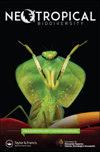Within-colony nest distribution of a waterbird mixed colony in a small alluvial forest at El Salvador
IF 0.8
Q4 ECOLOGY
引用次数: 0
Abstract
ABSTRACT Breeding in colonies is a defining characteristic of many waterbird species and several behavioural and habitat traits determine nest-site selection. Although there is relatively extensive literature on the topic, information on the within-colony distribution of nests lacks for mixed colonies, especially for ardeid-cormorant associations and in regions such as Central America. Here, geospatial data on vegetation associated with a mixed colony, established in a small alluvial forest northwest of El Salvador and collected from June to November 2015 was assessed to identify some behavioural and habitat features that could influence nest-site selection. Four ardeid species (Ardea alba, Egretta thula, Bubulcus ibis, and Nycticorax nycticorax) and one cormorant (Phalacrocorax brasilianus) conformed the colony, where the last was the outstanding species. The total area of the colony was 2.14 ha (14% of La Barra forest) with high nest densities (584.58 nests/ha). Spatial analyses indicate that some species prefer to occupy trees/shrubs close to other trees/shrubs with conspecific or similarly sized species. A remarkable height-strata distribution was found, with large-sized species in the canopy, and small-sized species in the lower strata. The resulting estimates of the generalized linear models applied suggest that the within-colony nest-site selection is determined by the combination of higher heights of the tree/shrub used for nesting, nearest distance to a food source, fewer species sharing the same tree/shrub and an increasing effect of the interaction of the latter two factors. Finally, the temporal evolution of La Barra’s colony shows that the increasing number of Neotropical Cormorants (Phalacrocorax brasilianus) could be shaping and threatening the colony’s species structure and possibly the vegetation as well. Conservation measures should be implemented to manage the population of this species.萨尔瓦多小冲积森林中水鸟混合群落的巢内分布
群居繁殖是许多水鸟物种的一个决定性特征,一些行为和栖息地特征决定了巢址的选择。虽然关于这一主题的文献相对广泛,但关于混合殖民地的巢穴分布的信息缺乏,特别是对于鸬鹚-鸬鹚协会和中美洲等地区。本研究评估了2015年6月至11月在萨尔瓦多西北部一个小型冲积森林中收集的与混合群落相关的植被地理空间数据,以确定可能影响筑巢地点选择的一些行为和栖息地特征。群落中有4种鹭科动物(Ardea alba、Egretta thula、Bubulcus ibis、Nycticorax Nycticorax)和1种鸬鹚(Phalacrocorax brasilianus),其中以鸬鹚为突出种。种群总面积为2.14 ha(占La Barra森林面积的14%),巢密度较高(584.58个/ha)。空间分析表明,一些物种更喜欢占据与同类或相似大小的其他树木/灌木接近的树木/灌木。高层分布明显,林冠层有大种,下层有小种。应用广义线性模型的结果估计表明,群落内筑巢地点的选择是由用于筑巢的树/灌木的高度较高、距离食物来源最近、共享同一树/灌木的物种较少以及后两者相互作用的增强作用共同决定的。最后,La Barra群落的时间演化表明,新热带鸬鹚(Phalacrocorax brasilianus)数量的增加可能正在塑造和威胁该群落的物种结构,甚至可能危及植被。应采取保护措施来管理该物种的数量。
本文章由计算机程序翻译,如有差异,请以英文原文为准。
求助全文
约1分钟内获得全文
求助全文
来源期刊

Neotropical Biodiversity
Environmental Science-Ecology
CiteScore
1.80
自引率
0.00%
发文量
39
审稿时长
24 weeks
 求助内容:
求助内容: 应助结果提醒方式:
应助结果提醒方式:


